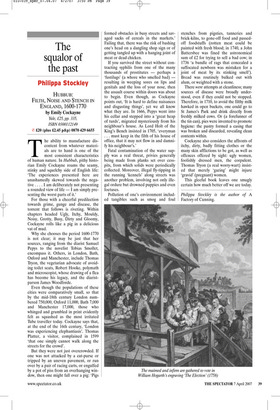The squalor of the past
Philippa Stockley
HUBBUB: FILTH, NOISE AND STENCH IN ENGLAND, 1600-1770 by Emily Cockayne Yale, £25, pp. 335, ISBN 0300112149 ✆ £20 (plus £2.45 p&p) 0870 429 6655 The ability to manufacture discontent from whatever materials are to hand is one of the most consistent characteristics of human nature. In Hubbub, pithy historian Emily Cockayne roams the seamy, stinky and squelchy side of English life: ‘The experiences presented here are unashamedly skewed towards the negative . . . . I am deliberately not presenting a rounded view of life — I am simply presenting the worst parts of it.’ For those with a cheerful predilection towards grime, gunge and disease, the torrent that follows is riveting. Within chapters headed Ugly, Itchy, Mouldy, Noisy, Grotty, Busy, Dirty and Gloomy, Cockayne rolls like a pig in a delicious vat of mud.
Why she chooses the period 1600-1770 is not clear; it may be just that her sources, ranging from the diarist Samuel Pepys to the novelist Tobias Smollet, encompass it. Others, in London, Bath, Oxford and Manchester, include Thomas Tryon, the vegetarian advocate of avoiding toilet seats, Robert Hooke, polymath and microscopist, whose drawing of a flea has become his legacy, and the diaristparson James Woodforde.
Even though the populations of these cities were comparatively small, so that by the mid-18th century London numbered 750,000, Oxford 11,000, Bath 7,000 and Manchester 17,000, those who whinged and grumbled in print evidently felt as squashed as the most irritated Tube traveller today. Cockayne says that, at the end of the 16th century, ‘London was experiencing elephantiasis’. Thomas Platter, a visitor, complained in 1599 ‘that one simply cannot walk along the streets for the crowd’.
But they were not just overcrowded. If one was not attacked by a cut-purse or tripped by an uneven pavement, or run over by a pair of racing carts, or engulfed by a pot of piss from an overhanging window, then one might fall over a pig: ‘Pigs formed obstacles in busy streets and savaged sacks of cereals in the markets.’ Failing that, there was the risk of bashing one’s head on a dangling shop sign or of getting tangled up with a hanging joint of meat or dead chicken.
If you survived the street without contracting syphilis from one of the many thousands of prostitutes — perhaps a ‘fustilugs’ (a whore who smelled bad) resulting in weeping sores on lips and genitals and the loss of your nose, then the assault course within doors was about to begin. Even though, as Cockayne points out, ‘It is hard to define nuisances and disgusting things’, yet we all know what they are. In 1666, Pepys went into his cellar and stepped into a ‘great heap of turds’, migrated mysteriously from his neighbour’s house. As Lord Holt of the King’s Bench insisted in 1705, ‘everyman . . . must keep in the filth of his house of office, that it may not flow in and damnify his neighbour’s.’ Fatal contamination of the water supply was a real threat, privies generally being made from planks set over cesspits, from which solids were periodically collected. Moreover, illegal fly-tipping in the running ‘kennels’ along streets was another problem, involving not only illegal ordure but drowned puppies and even foetuses.
Pollution of one’s environment included tangibles such as smog and foul stenches from pigsties, tanneries and brick-kilns, to gone-off food and passedoff foodstuffs (rotten meat could be painted with fresh blood; in 1740, a John Battersbee was fined the astronomical sum of £2 for trying to sell a bad cow; in 1736 ‘a bundle of rags that concealed a suffocated newborn was mistaken for a joint of meat by its stinking smell’). Bread was routinely bulked out with alum, or weighted with a stone.
There were attempts at cleanliness; many sources of disease were broadly understood, even if they could not be stopped. Therefore, in 1710, to avoid the filthy milk hawked in open buckets, one could go to St James’s Park and drink directly from freshly milked cows. Or (a forefunner of the tin can), pies were invented to promote hygiene: the pastry formed a casing that was broken and discarded, revealing clean contents within.
Cockayne also considers the affronts of itchy, dirty, badly fitting clothes or the many skin afflictions to be got, as well as offences offered by sight: ugly women, foolishly dressed men, the corpulent. Thomas Tryon (a real worry-wart) insisted that merely ‘gazing’ might injure ‘gravid’ (pregnant) women.
This gleeful book leaves one smugly certain how much better off we are today.
Philippa Stockley is the author of A Factory of Cunning.


































































 Previous page
Previous page